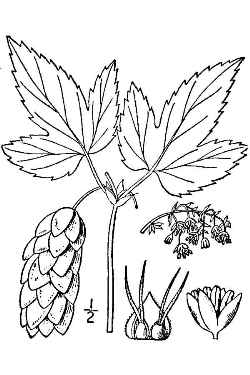
Britton, N.L., and A. Brown. 1913. Illustrated flora of the northern states and Canada. Vol. 1: 633. Courtesy of Kentucky Native Plant Society.
Sunset®: All zones
USDA: 4-10
Frost Tolerance: A severe frost will kill young, tender vines in spring.
Sun Exposure: Full sun
Origin: Europe and western Asia. Naturalized in many areas.
Growth Habits: Perennial herbaceous vine, annual stems fast growing to 30 feet in length (9 m); opposite, hairy, cordate, 3- to 5-lobed leaves
Flowers: Greenish flowers
Watering Needs: Regular water during growth
Propagation: Seeds (that need a dormancy period), layerings, cuttings, runners that arise from the crown just below the soil surface, roots planted in the spring
The bitter substance obtained from glands on the hop cone (strobilus) is used by brewers for giving aroma and flavor to beer, as well as for its preservative value.
Propagation:
The hop is dioecious, inflorescence on female plants is cone-like, 1 to 2 inches (2.5–5 cm) long. The flowers on male plants are organized in long racemes. The flowers come from early July to late August.
Desert-Tropicals is dedicated to provide gardening advice, gardening ideas, and information about flower of all kind for landscape and collections.We try to check carefully the identification of the plants on the illustrations as well as the other information from the page, but occasionally errors do occur. if you notice anything that needs to be changed please contact us.Thanks.
© 1998-2020 Philippe Faucon, All Rights Reserved.